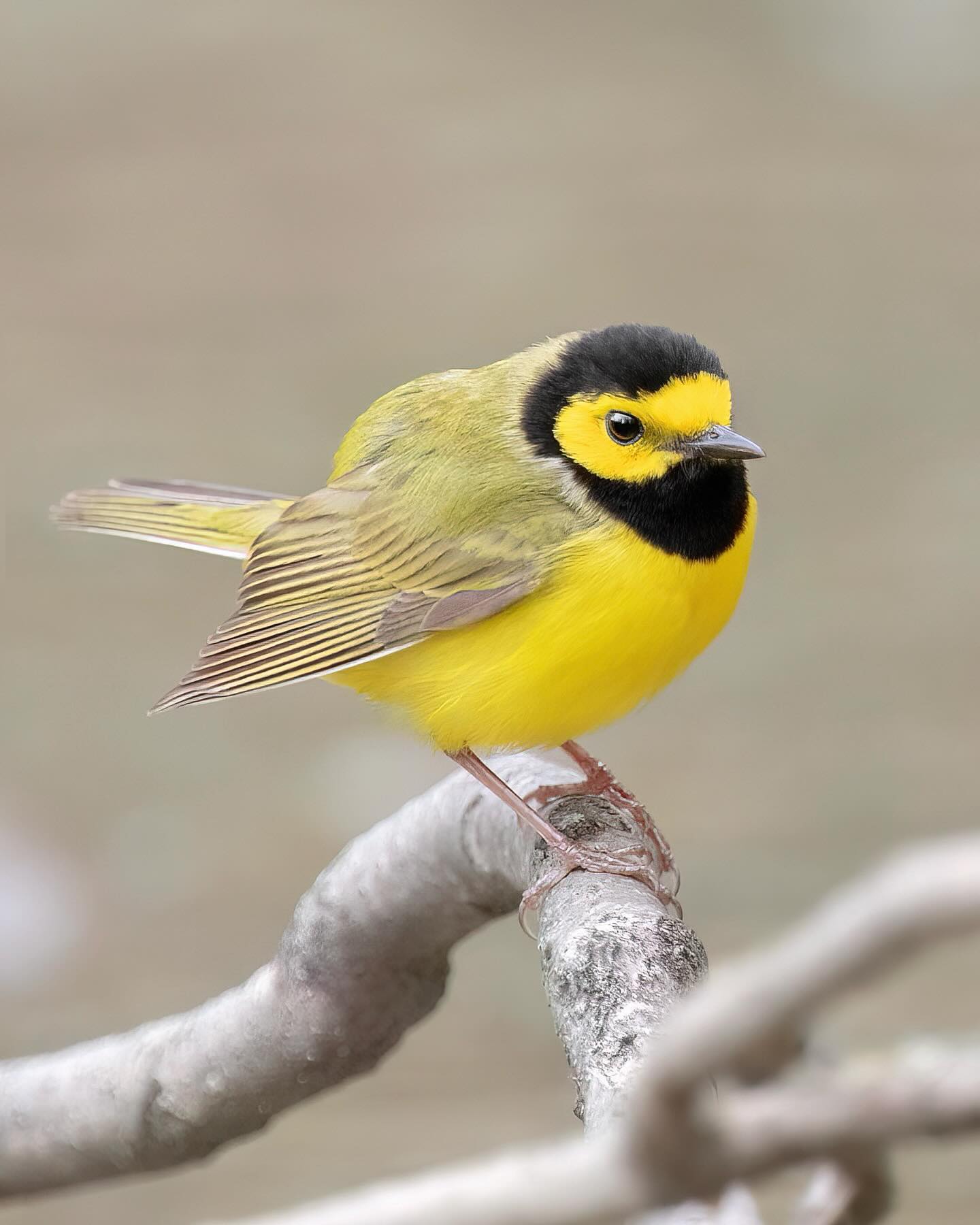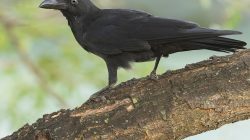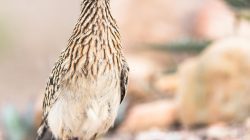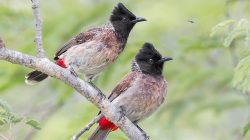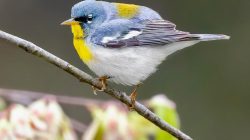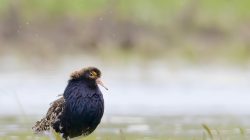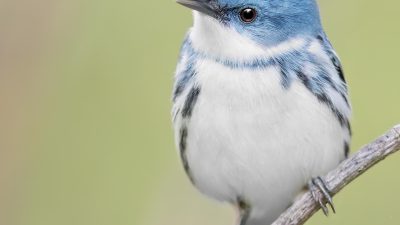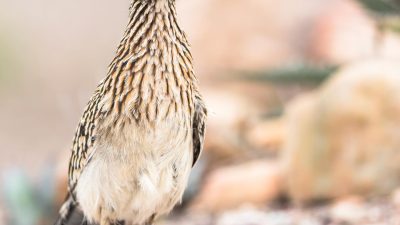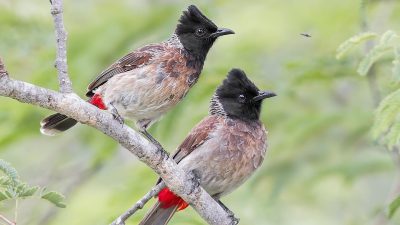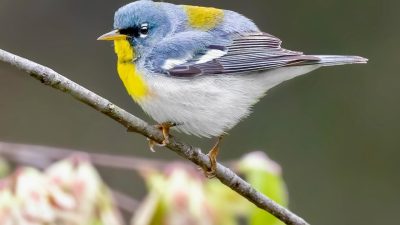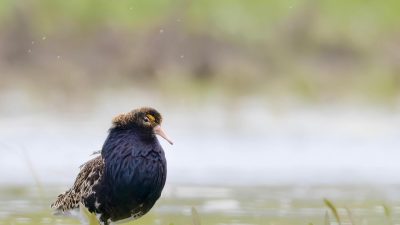Hooded Warbler (Setophaga citrina): A Comprehensive Study of a Vivid Avian Species
Diajar.net – The Hooded Warbler (Setophaga citrina) is a small and vibrant songbird known for its striking plumage and distinctive songs. Found primarily in the eastern parts of North America, this species has captivated birdwatchers and ornithologists due to its stunning appearance and fascinating behaviors. In this detailed study, we will explore the geographic range, habitat, physical description, reproduction, lifespan and longevity, behavior, communication and perception, food habits, predation, ecosystem roles, economic importance for humans (positive and negative), conservation status, and the key contributors to the species’ study and protection.
Geographic Range
The Hooded Warbler is a migratory bird found primarily in the eastern United States and parts of Canada, though it also ranges into the Caribbean during migration. Its breeding range is predominantly in the eastern forests, from southern New England and southern Ontario down to the Gulf Coast and parts of Florida. The species is most abundant in eastern deciduous forests, particularly in areas with dense undergrowth and shrubs, where it can find its preferred habitat for nesting and feeding.
During the winter months, the Hooded Warbler migrates to Central America and the Caribbean, including Jamaica, Hispaniola, and Puerto Rico, where it spends the colder months. This migration allows the species to avoid the harsh winters of North America, which are unsuitable for breeding and foraging.
The Hooded Warbler’s migration patterns are regular and predictable, with birds moving from their breeding grounds in the United States to their wintering grounds in the tropical regions of Mexico and the Caribbean, returning each spring. This seasonal migration is critical for its survival, as it helps the species maintain access to optimal food sources during the different seasons.
Habitat
The Hooded Warbler thrives in deciduous forests and woodland areas with abundant underbrush, shrubs, and small trees. It is typically found in habitats with a mix of forest canopies and dense undergrowth, where it can easily find food and shelter. The species is particularly attracted to areas with a diverse shrub layer, including dogwoods, hazel, blueberries, and holly, as these plants provide both nesting sites and food sources.
During the breeding season, the Hooded Warbler prefers mature forests, where the forest floor is rich in low-lying plants and dense vegetation. These forests offer ample cover for nesting and protection from predators. However, the species is also known to occupy more scrubby and secondary growth forests, especially in regions where primary forests have been disturbed or fragmented.
In terms of its winter habitat, the Hooded Warbler migrates to tropical forests and woodland edges in the Caribbean and Central America. It thrives in environments with dense vegetation and is often seen foraging in the underbrush of tropical and subtropical forests, where it can find insects and other food sources.
Physical Description
The Hooded Warbler is a small, vibrant bird with distinctive physical features that make it easily recognizable. Adult males are particularly striking, with their characteristic yellow and black plumage.
Male Hooded Warbler
The adult male Hooded Warbler is most notable for its bright yellow underparts and its black hood, which covers the head, throat, and upper chest, creating a stark contrast with the yellow body. The black hood is the feature that gives the bird its name, as it resembles a “hood” or “mask” that contrasts sharply with the bird’s otherwise colorful appearance. The back and wings of the male are olive-green, while the tail is a darker olive color with faint white edges. The eyes are dark, and the bird has a small, thin bill that is slightly upturned.
Female Hooded Warbler
The female Hooded Warbler is similar in shape and size but has a more dull coloration compared to the male. Her yellow underparts are less intense, and her black hood is replaced with a more subtle grayish-brown crown, which is still noticeable but not as striking. The olive-green coloration on the back and wings is similar to that of the male, but it is more muted. Females also have a smaller, less prominent black throat patch, and their plumage lacks the vivid contrast that the males display.
The Hooded Warbler measures about 12–13 cm (4.7–5.1 inches) in length, with a wingspan of around 20 cm (8 inches). Despite its small size, the bird’s colorful plumage and energetic movements make it a delight to observe in the wild.
Reproduction
The Hooded Warbler’s reproductive behavior follows typical patterns for North American warblers. The breeding season begins in spring, and males arrive on the breeding grounds first, establishing territories and attracting females with their songs and displays. The males often sing from a perch in the midstory or canopy of the forest, using their loud and melodious songs to communicate with potential mates.
Nesting
The female builds the nest, which is typically located in the dense underbrush or low shrubs, hidden among vegetation to protect the young from predators. The nest is cup-shaped and made from grasses, leaves, small twigs, and animal hair, providing a safe and secure environment for the eggs and chicks. After mating, the female lays 4-5 eggs, which are incubated for about 11-12 days.
Chick Development
Once hatched, the chicks are fed primarily on insects, including caterpillars, beetles, and spiders. Both parents are involved in feeding and protecting the young. After about 9-12 days, the chicks fledge, or leave the nest, though they remain dependent on the parents for food for some time afterward.
The Hooded Warbler typically raises one brood per year, though in some years, two broods may be raised, depending on environmental conditions and food availability.
Lifespan/Longevity
The average lifespan of the Hooded Warbler in the wild is difficult to determine precisely, as many individuals do not survive beyond their first year due to predation, disease, or other environmental factors. However, adult Hooded Warblers that do survive to maturity can live for up to 5-7 years, although few individuals reach this age due to the various challenges they face.
The species’ short lifespan is common among small songbirds, many of which face significant mortality rates in their first year. Factors such as harsh weather conditions, predation, and habitat destruction all contribute to the relatively short life expectancy of the Hooded Warbler.
Behavior
The Hooded Warbler is an active and energetic bird, with behaviors typical of many warblers. It is known for its agile flight and quick movements as it forages for insects in the understory and midstory of forests. The bird is often seen fluttering or hopping between branches, leaves, and shrubs in search of food. During the breeding season, males are particularly active in defending their territory and engaging in song displays to attract females.
The species is generally solitary or found in pairs during the breeding season but may form small flocks during migration, especially in the fall when food is abundant. Despite their social tendencies outside of breeding, Hooded Warblers are primarily territorial and can be quite aggressive in defending their nesting sites from other birds.
Communication and Perception
The Hooded Warbler relies heavily on vocalizations and visual signals for communication. During the breeding season, males sing loud, clear songs from perches in the canopy, using these songs to establish territory and attract females. The songs are a series of melodious whistles and chirps, which are distinct and recognizable. In addition to vocal communication, males also perform flights displays, including fluttering or hovering, to showcase their strength and attract mates.
The bird’s ability to perceive its environment is also highly developed, especially in terms of sight and hearing. The Hooded Warbler has excellent vision, which aids it in detecting potential predators and locating food. It also has acute hearing, which helps it respond quickly to calls from other birds or detect insects and prey in dense foliage.
Food Habits
The Hooded Warbler is primarily insectivorous, feeding on a wide variety of insects and arthropods. Its diet consists mainly of caterpillars, beetles, flies, spiders, and other small invertebrates. During the breeding season, the bird needs to consume large quantities of insects to fuel its high-energy lifestyle and to feed its young.
The Hooded Warbler forages primarily in the underbrush and midstory of forests, where it actively searches for insects by hovering, flicking, or catching prey mid-flight. Its diet is high in protein, which is essential for its growth, reproduction, and migration.
Predation
Like many small songbirds, the Hooded Warbler faces numerous threats from predators. These predators include hawks, snakes, raccoons, and various bird species that may raid nests or attack young chicks. The Hooded Warbler’s small size and vibrant plumage make it vulnerable to predation, particularly during the nesting season when the young are defenseless.
To avoid predators, Hooded Warblers use their agility and camouflage to hide in the dense underbrush, often remaining still and silent when they sense danger. In addition, their vocalizations may serve as an early warning signal, alerting other birds in the area of the presence of a predator.
Ecosystem Roles
The Hooded Warbler plays an important role in its ecosystem as both a predator and a prey species. As an insectivorous bird, it helps control populations of insects, particularly caterpillars and beetles, which can be pests to plants. By feeding on these insects, the Hooded Warbler helps maintain a balance in the ecosystem, preventing any one species from becoming too dominant.
Additionally, the Hooded Warbler serves as prey for larger predators, contributing to the food web. Its presence in forest ecosystems is an indicator of a healthy, biodiverse habitat, as warblers are often sensitive to changes in their environment.
Economic Importance for Humans: Positive
The Hooded Warbler indirectly benefits humans by contributing to pest control. As a primary consumer of insects, it helps regulate the population of many species that could potentially damage crops and forests. Warblers like the Hooded Warbler are also beneficial to agriculture and horticulture, where they help control pest insects that damage fruit trees, vegetables, and ornamental plants.
Furthermore, the Hooded Warbler contributes to ecotourism and birdwatching, providing economic value through the promotion of nature tourism. Birdwatchers are often drawn to the vibrant colors and melodious songs of the Hooded Warbler, supporting local economies in areas where the species is found.
Economic Importance for Humans: Negative
While the Hooded Warbler provides numerous ecological benefits, its presence can sometimes be seen as a negative in terms of its role as competitor for resources. The species competes with other bird species for nesting sites, particularly in forested environments. This competition for nesting sites can occasionally result in territorial conflicts between the Hooded Warbler and other species, although these occurrences are relatively rare.
Additionally, the Hooded Warbler’s migration patterns can be influenced by climate change, which may disrupt migration schedules or alter food availability, leading to shifts in ecosystems that affect agricultural practices.
Conservation Status
The Hooded Warbler is currently listed as Least Concern by the International Union for Conservation of Nature (IUCN) due to its relatively stable population and wide geographic distribution. However, the species is still vulnerable to habitat loss, particularly the destruction and fragmentation of its forest habitats.
The species is protected under the Migratory Bird Treaty Act in the United States, which helps preserve its habitats and reduce the risk of hunting or habitat destruction. Conservation efforts are essential to ensure that the Hooded Warbler’s populations remain stable, particularly in areas where forests are being cleared or degraded due to urbanization or industrial activities.
Contributors
Key contributors to the study and conservation of the Hooded Warbler include ornithologists, conservation organizations, and environmental agencies that work to monitor the bird’s population and habitat. Organizations such as the National Audubon Society and BirdLife International have been instrumental in advocating for the protection of forest ecosystems and the promotion of sustainable land-use practices.
Research institutions and universities also play a crucial role in studying the Hooded Warbler’s migration patterns, nesting habits, and ecological interactions. Through these efforts, scientists continue to gain valuable insights into the species’ behavior and ecology, aiding in the development of effective conservation strategies.
Conclusion
The Hooded Warbler (Setophaga citrina) is a fascinating and colorful bird with a vital role in the ecosystems it inhabits. Its migration patterns, vibrant plumage, and insectivorous diet make it a unique and important species in North America’s forests. While the Hooded Warbler’s population remains relatively stable, continued conservation efforts are necessary to protect its habitats from fragmentation and degradation. By supporting the preservation of forest ecosystems and promoting sustainable land use, we can help ensure the future of this beautiful and ecologically significant bird.
